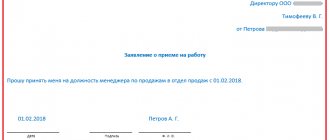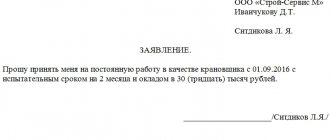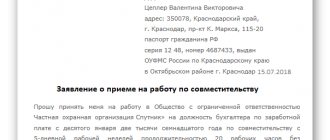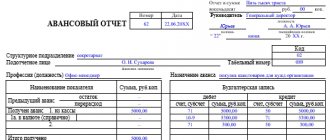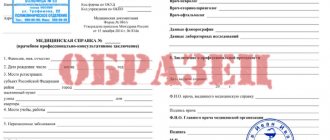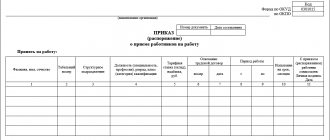Who should receive induction training?
The list of persons who must receive instructions from the employer is given in paragraph 1 of clause 2.1.2 of the Training Procedure.
These include:
- citizens newly hired;
- workers seconded to the organization;
- temporary workers; specialists from third-party companies performing work in a designated area;
- students undergoing practical training;
- other persons who participate in production activities.
The employer has no right to allow persons to work who have not completed induction training.
Features of conducting labor safety briefings
In practice (employers) the question very often arises: is it necessary to provide instructions on labor protection to employees who work at home, remotely or in the office, and, at first glance, do not face any threats or dangers in their activities?
We remind you: all employees, without exception, undergo induction training, regardless of the location and nature of the work performed.
Instructions on labor protection in the workplace are also mandatory for all employees. But here the employer has the right to include some positions/professions not related to the use, operation, maintenance, testing, adjustment and repair of equipment, the use of electrified or other mechanized hand tools, storage and use of raw materials, which, as a rule, include employees office, to the list of those exempt from on-the-job training.
Who conducts the induction training?
Persons who can instruct new employees on labor protection are listed in clause 2.1.2 of the Training Procedure. It can be:
- Head of the organization;
- occupational safety specialist;
- an employee who is assigned these duties by order of the employer.
The employee who conducts the instruction must undergo training and knowledge testing on labor protection at an accredited educational center.
If the director is the sole founder of the company and an employment contract has been concluded with him, he must conduct an introductory briefing to himself (letter of Rostrud dated April 27, 2017 No. PG/08346-03-3).
Procedure and timing of labor safety briefings?
| Type of instruction | In what cases is it carried out? | Who is it for? | Who conducts |
| Introductory | - when applying for a job | to all employees | occupational safety specialist/responsible person appointed by order |
| Primary | - when applying for a job | to all employees Exception: employees who are exempt from training by order of the head of the organization in accordance with clause 2.1.4. Resolution No. 1/29 of January 13, 2003 | immediate supervisor of work appointed by order |
| Repeated | - regularly, at least once every 6 months or at least once every 3 months, if the work is associated with increased danger and this requirement is established by industry regulations on labor protection | to all employees Exception: employees who are exempt from training by order of the head of the organization in accordance with clause 2.1.4. Resolution No. 1/29 of January 13, 2003 | immediate supervisor of work appointed by order |
| Unscheduled | — at the request of supervisory authorities; — after an emergency or accident occurs; — when launching new equipment; — when new labor protection requirements come into force; - after a long production downtime. | the list of employees is determined by order of the head of the organization | immediate supervisor of work appointed by order |
| Target | — when performing one-time work not related to direct job responsibilities; — when eliminating the consequences of accidents and natural disasters; — when performing work according to the work permit; — when organizing public events and excursions. | the list of employees is determined by order of the head of the organization | immediate supervisor of work appointed by order |
Induction program
The employer independently develops a training program taking into account the specifics of the company's activities. An approximate list of questions for drawing up a program can be found in Appendix B to GOST 12.0.004-2015.
The program lists a list of questions that need to be brought to the attention of the person being instructed, and the time allotted for them.
Such a program must be approved by order of the organization. The order must indicate the employee responsible for conducting the training. Such an employee must be familiarized with the order, where the employee must sign and date the familiarization.
Registration of labor safety briefings
It is important to remember that it is not enough for an employer to simply provide instructions on labor protection. All labor safety briefings must be completed with an oral assessment of the knowledge and skills acquired by the employee. Only after successful completion of the instructions does the employee receive the right to begin performing his/her job duties.
The fact of undergoing labor safety briefings is recorded in the appropriate journals with the obligatory indication of the signature of the person being instructed and the signature of the instructing person, as well as the date of the event.
Completion of induction training is recorded in the “Logbook of registration of induction training on labor protection”.
Recommended journal format:
Completion of initial, repeated, unscheduled and targeted briefings is taken into account in the “Logbook of registration of briefings on labor protection in the workplace.”
Recommended journal format:
When entering information about an unscheduled briefing into the log, it is necessary to indicate the reason for it, as well as the number and name of the manager’s order.
Timing and duration of instructing new employees
The employer is required to conduct induction training for a new employee on the day of his actual hiring. This follows from the explanations given by the Ministry of Labor in letter dated 05.05.2017 No. 15-2/OOG-1277. A candidate for a vacant position is not an employee, so there is no need to instruct him on occupational safety. Employers should also remember that, in addition to induction, the law provides for initial training in the workplace. It is carried out directly at the employee’s workplace after introductory instructions, but before admission to independent work.
The duration of the event must correspond to the program approved by the organization, which is developed on the basis of legislative and other regulatory legal acts of the Russian Federation, taking into account the specifics of the activity. Typically, the time it takes is from 4 hours to two working days (depending on production volumes).
Need a program
For an event that is carried out on an ongoing basis, such as induction training, you need a program developed and approved by the management of the organization. It can be created either by a labor protection specialist or by a third-party organization performing similar functions. The program must contain the following information:
- brief content of the briefing;
- detailed explanation of each item;
- who will conduct this type of instruction;
- on the basis of which document;
- timing.
Program approval
Performed by the head or head of the labor protection service, if there is one at the enterprise. For approval, an order is issued for the organization, the number of which is indicated on the title page of the program, and is also sealed with the personal signature of the person who made the approval.
IMPORTANT! In some cases, the induction program requires agreement with the trade union or specific specialists.
Approximate list of points of introductory training on occupational safety
GOST 12.0.004-90 in Appendix 3 provides sample questions that must be covered during induction training. Each item in the program should be described in detail, preferably in the form of a finished text. Here are some sample “supports” that will help in compiling such a text.
- General information about the enterprise.
- Specifics of activity.
- Important points of legislation regarding labor protection:
- what is stated in the employment contract;
- work and rest schedule;
- features of the work of minors;
- how women's labor is protected;
- required compensation and benefits.
- Internal regulations and responsibility in case of violations.
- How to behave on the territory, as well as other premises belonging to the organization.
- Where are all the important facilities in the enterprise located?
- What factors can cause harm or danger?
- What and how exactly is used to prevent accidents:
- protective equipment (collective and individual);
- warning signs;
- alarm, etc.
- Requirements for sanitation and personal hygiene during the work process.
- Analysis of accidents that have already occurred.
- Fire safety. Personnel procedures.
- What to do if an accident does occur.
- How to help those who have suffered.
- How this organization handles and investigates emergency situations.
ATTENTION! Many professional websites on the Internet provide program templates that can be easily adapted to specific organizations.
Who can be an instructor
This is an important issue that the employer needs to decide before issuing an order for induction training. People who can conduct such training are identified in clause 7.8 of GOST 12.0.004-90. These may include:
- trained specialist – labor protection engineer;
- an experienced worker selected for this purpose by management;
- the boss himself or his representative;
- a representative of an accredited organization involved in labor protection;
- foreman, teacher, foreman, head of a structural unit, etc.
NOTE! The responsibility of the instructor selected to conduct the introductory briefing is fixed in the management order.
Main conclusions
Introductory briefing on labor protection is the basis of labor protection at the enterprise, so to speak, the foundation of the employee’s attitude towards compliance with safety requirements at work.
Therefore, you need to take its implementation seriously; you can prepare and show a presentation or videos to future employees.
Such a thorough approach gives occupational safety and health a more significant status, and in the eyes of employees the enterprise will look more impressive.
Otherwise, occupational safety and health will not be taken seriously. And this is important.
Because the introductory briefing on labor protection, the labor protection program, all the various registration logs and forms are aimed at preserving human life and health, on which, among other things, the fate and activities of the enterprise itself and its responsible persons depend.
I wish you efficient and safe work!
If after reading the article you have questions, write in the comments; if you need to draw up programs or other documents, contact me - I’ll do it on time, I’ll accompany you, help you, check it!
Introductory briefing: answering questions
The enterprise is restructured, changing its name or form of ownership. At the same time, the production situation at existing workplaces does not change. Do I need to re-organize the induction training?
Yes, in this case, all employees of the organization will have to go through this training again. Before this, it is necessary to develop and approve in the prescribed manner a new induction program on labor protection. In fact, those responsible for its development only have to supplement the old program with information about the newly formed enterprise.
What is the responsibility for failure to comply with the instructions of the introductory briefing on labor protection?
If induction training in an organization is not carried out at all, a fine is imposed on the employer: about 15–25 thousand rubles. for non-legal entities and 100–130 thousand rubles. - for legal entities. If briefings are carried out, but of poor quality, fines are imposed on the officials responsible for this work.
In which organization do subcontractors undergo induction training - at the general contractor or at the customer?
If employees of subcontracting organizations perform work at the customer’s sites and do not visit the general contractor’s territory, then they undergo introductory training organized by the OT service of the customer organization. If the general contractor has organized ongoing cooperation with the subcontractor at different sites, then an introductory briefing should be carried out to avoid possible misunderstandings or inconsistencies.
How to organize a knowledge test based on the results of the introductory briefing if about 50 people take it at the same time?
Labor protection legislation stipulates that any type of labor protection training, including briefings, ends with a knowledge test. In terms of briefings, there are no requirements for the organization’s format for testing knowledge; it can be carried out in a way that is convenient for the organization’s employees. For example, you can ask questions orally before the person being instructed signs, or organize a computer test. It is advisable to prescribe the format for testing knowledge based on the results of the briefing in the instructions for its conduct.
How to arrange introductory briefings for students who come to a lesson or activity in the sports section?
You can register introductory instruction, which is carried out for students at the beginning of their studies, in educational logbooks and workbooks of circle leaders. There is no need to create separate journals for these purposes.
Recording those who have completed induction training
Each employee who has received an “induction” must be recorded in the appropriate journal according to the uniform form assigned to the enterprise. Typically the following information is recorded:
- date of instruction;
- Full name and position of the trainee;
- Full name and details of the instructor;
- signatures of both parties.
You can also enter additional information if the manager deems it necessary, for example, the results of checking the effectiveness of the training.
Requirements for business documentation require the pages of the magazine to be numbered, bound and sealed.
FOR YOUR INFORMATION! A sample of the title and first pages of this magazine must be added to the approved induction program as appendices.

